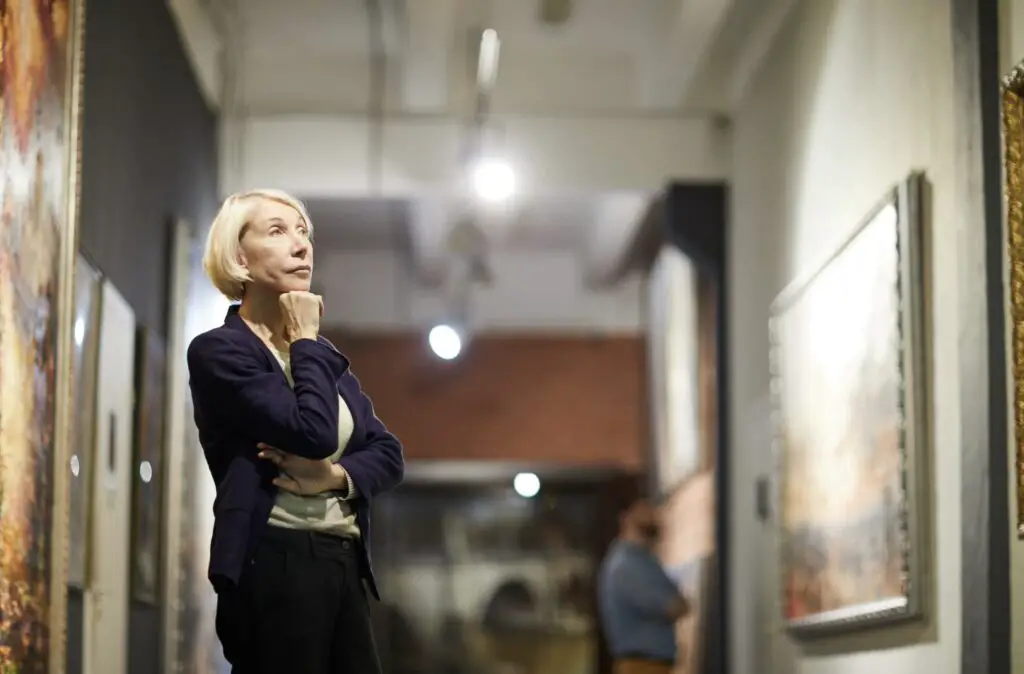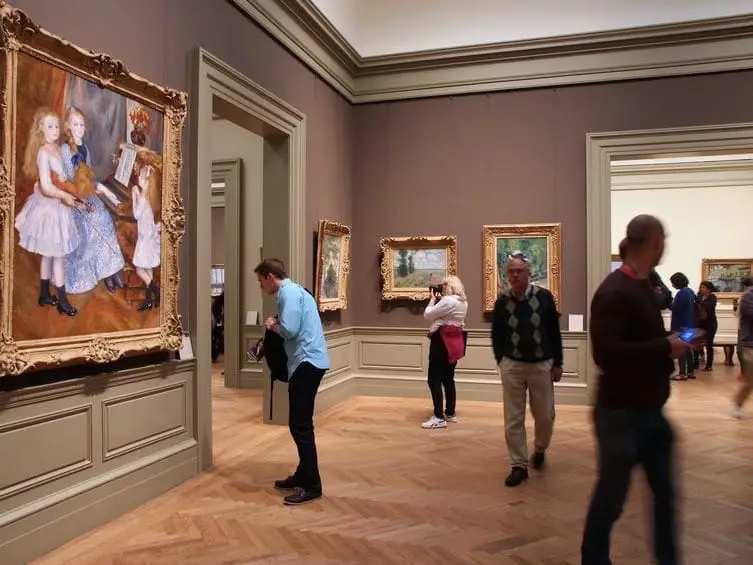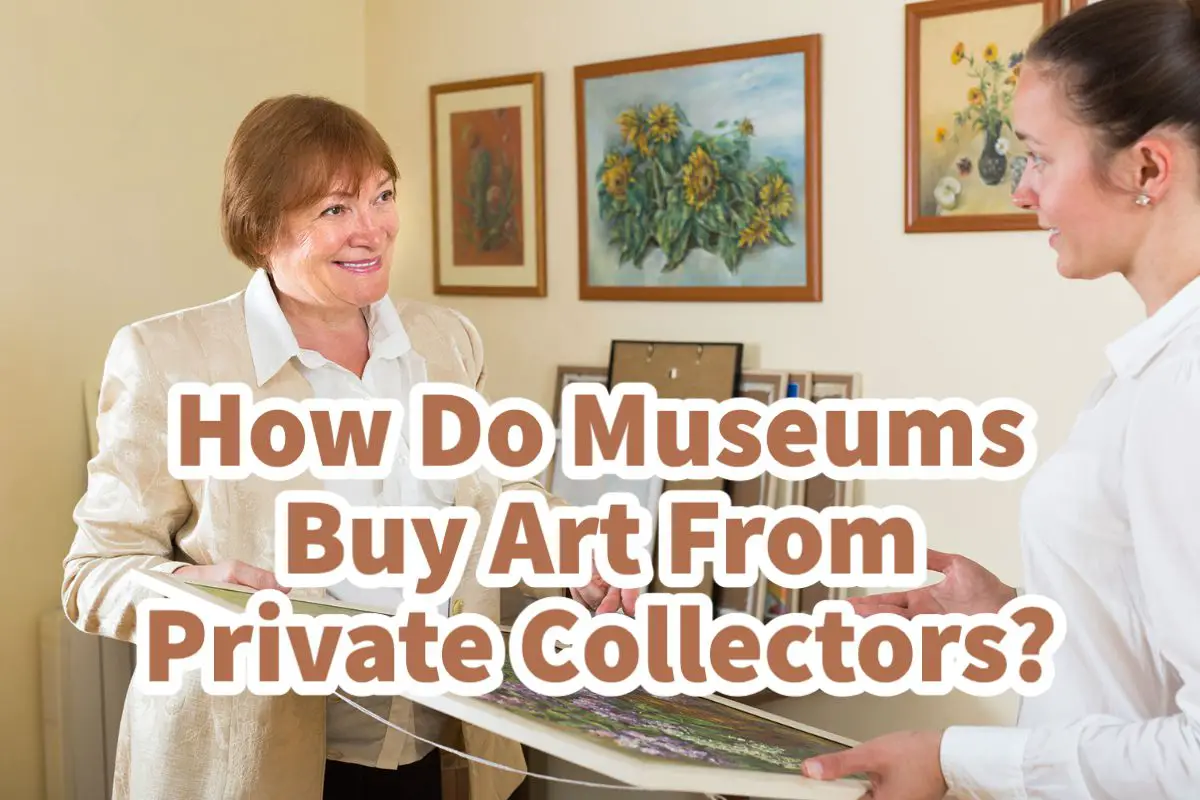When you go to an Art Museum and see all the incredible art displayed, many people wonder how a museum gets all this art. Do they buy it from private collections?
The art museums will purchase art with an art council working together with the art museum curators to decide what should be bought and why this work of art should be bought. The curator will usually present to the council why the museum should acquire a specific work of art and how that artwork is essential to the museum’s success. As purchasing art costs money, many museums prefer to acquire art through gifts or bequests and only buy what they know will add to a collection or overall museum success.
Table of Contents
- Ways Museums Acquire Art
- The Process Museum’s Use To Purchase Art
- Frequently Asked Questions
- Related Questions
Ways Museums Acquire Art
There are two ways that an art museum acquires works of art. One way is that the art is a gift or bequest or the artworks are purchased.
A gift is something that to given to the museum voluntarily. Usually, no money is exchanged, and someone will say I want to give this to you; a giver may stipulate some conditions to the gift.
A bequest is that the art is left in a will to a museum. Someone may have a work of art they want to enjoy until they die. Once they die, they will put the bequest in their will to give the work of art to a specific museum.
The final method is that the museums will purchase the art from a private collector. There is a process that most museums need to go through to buy art.
Museums and Purchasing Art
Museums are like almost any other business. They can only buy or purchase what they can afford. And what they are buying must make sense for their comprehensive collection. If a museum is going to acquire a work of art, they need to understand what they’re going to purchase and why, and also, they must have the funds to buy it.
This is why most museums do not purchase works of art as much as they will show pieces of art that are gifts or bequests. Buying art for a museum would need to make sense and help and add to the museum somehow.

The Process Museum’s Use To Purchase Art
Each museum may have its own setup or rules to decide how and what art they will purchase for their museums. But in general terms, the way the art is purchased will usually come about in a few ways.
Museums will have a process in place and rigorous protocol on making a purchase or acquisition.
Here are some ways a museum will help to ensure their acquisition makes sense for them:
Art Councils Or Patrons
Many art museums will set up an art council. These councils are comprised of volunteers who often pay a hefty fee to be part of the council. They are art patrons who are wealthy enough to donate to the museum if needed to help with an acquisition.
The fee they charge to be on the council also helps the museum know that those are serious. Museums have different rules for the amount they charge and the kind and type of people they look for in the council. The people on the board would usually be art patrons who are seriously committed to helping ensure the museum is successful.
Art Council Meets With Curators
This art council will meet with the curators twice yearly to propose or discuss possible acquisitions. The curator would give a presentation to explain why they feel this particular art acquisition would be a critical addition to the art museum.
A good curator has their eyes open and knows which artwork may be up for sale at what price and by whom. An art curator must have their network, sources, and knowledge to understand its sale and why.
The curator and art council will develop a list of artworks they want to acquire and why. The point to this is that the board will work with the curators and other people in the museum to help decide what work the museum should purchase and why.
This is not a decision that is left up to just one individual or one group, but it is a process that requires some consensus between the council that can be seen to represent the public the curators, and the museum.
Part of a good curator will also be to know if people in the community or other places have works of art they may be willing to give or bequest to the museum and work to ensure that does happen. This is important as for most museums, their ideal way of acquiring art is by gift or bequest and not purchase.
A good curator is very valuable to a museum as they have the knowledge and contacts to help ensure its success in art acquisitions.

Museums Fundraising And Galas
Many museums will hold an annual fundraising event to fund the museum. Many of these events are high-priced dinners where wealthy companies and individuals will sometimes purchase tables for hundreds of thousands of dollars. It is a way for the museums to raise funds while the rich show their support for the museum.
One of the most famous galas or fundraising events worldwide for a museum is the MET Gala. The Gala is a fashion event to earn money for New York’s Metropolitan Museum of Art. Many of the biggest stars from Hollywood and beyond will attend the MET Gala.
A ticket for the MET Gala is about 30,000 USD per person. With 500 to 600 people attending the event, the MET would earn a minimum of 13 to 15 million USD. This money goes mainly to help fund the MET’s costume department. But the MET Gala shows the power of a successful museum fundraiser.
Undoubtedly, many art museums are struggling to stay open with their doors shuttered due to the pandemic. Many have had to close their doors or lay off personnel. Now more than ever, art museums will have to rely on the help of wealthy donors, fundraising, and other events.
I am very thankful for art museums. Art museums inspire me and help me to be a better artist. Anita Louise Art is dedicated to art education, great artists worldwide, and inspiring others to find and create their art. We look at all kinds of art made to uplift and inspire. #ArtToMakeYouSmile! #ArtToMakeYouHappy!
Anita Louise Art is dedicated to art education, great artists, and inspiring others to find and create their art. We love art that uplifts and inspires. #ArtToMakeYouSmile! #ArtToMakeYouHappy!
If you want to see any of my art, you can find out more by clicking here. If you are interested in what inspires me and my paintings, you can discover more by clicking here.
We have a free newsletter and would love you to be part of our community; you can subscribe to the newsletter by clicking here. I would be happy to talk to you anytime if you have any questions. You can reach me, Anita, by clicking here.
Subscribe to our Anita Louise Art YouTube Channel filled with great videos and information by clicking here.
Join us for our podcast “5 Minutes With Art.” Spend just 5 minutes a week with us to discover and learn about great art and artists. You can find out more about our podcast by clicking here.
Frequently Asked Questions
How do museums decide which artworks to purchase from private collectors?
Museums typically have an art council and curators who collaborate to make acquisition decisions. The curator presents the significance of a specific artwork to the council, emphasizing its importance to the museum’s overall collection and success.
Why do museums choose to buy art from private collectors instead of relying solely on gifts or bequests?
While gifts and bequests are preferred, museums may opt to purchase art to strategically enhance their collections. Buying art allows for more intentional curation and ensures that specific pieces contribute to the museum’s goals.
Who is involved in the process of acquiring art from private collectors?
The process usually involves collaboration between the museum’s art council, curators, and sometimes external experts. The curator plays a pivotal role in presenting the case for acquisition.
How do museums fund the purchase of art from private collectors?
Museums allocate budgets for acquisitions, which can come from various sources, including donations, grants, and revenue generated from museum activities. Funding is carefully managed to prioritize acquisitions that align with the museum’s mission.
Are there specific criteria for selecting artworks to be purchased?
Yes, there are various criteria, including artistic significance, historical importance, relevance to the museum’s collection, and potential educational value. The decision is guided by the museum’s mission and long-term goals.
Do museums ever negotiate prices with private collectors when buying art?
Yes, negotiations can occur. Museums aim to strike a balance between the importance of the artwork and the available budget. Negotiations may involve discussing the price, potential loans, or other arrangements.
Are there restrictions on the types of artworks museums can acquire from private collectors?
Museums may have specific guidelines or restrictions based on their collection policies. These policies often outline the types of artworks that align with the museum’s mission and vision.
Can private collectors donate art to museums instead of selling it to them?
Absolutely. Many museums rely on donations, and collectors often choose to contribute their artworks as gifts or bequests. Donated pieces can significantly enrich a museum’s collection.
How do museums ensure the authenticity of artworks acquired from private collectors?
Museums employ experts, including art historians and conservators, to authenticate artworks. Thorough research and examination are conducted to verify the provenance, authorship, and condition of the acquired pieces.
Do museums disclose details about their art acquisitions from private collectors to the public?
Museums often share information about new acquisitions through press releases, exhibitions, or publications. Transparency is valued, and museums may provide insights into the decision-making process behind each acquisition.
Related Questions
How Do Art Museums Choose What To Exhibit?
Art museums choose what they want to exhibit because of costs, budget restraints, and space restraints. They want to show art that the public wants to see and exhibitions the people are willing to pay an entrance fee to attend. A museum also exhibits those works of art that align with its mission and vision.
By clicking here, you can learn more by reading How Do Art Museums Choose What To Exhibit?
The Important Role Of Art Museums In The Art World
An art museum will help to collect and preserve works of art. They also interpret the art and help to educate us all about art. Many art museums will have programs that will allow you to experiment with different types of art. The core role of an art museum is to inspire us about art.
You can discover more by reading The Important Role Of Art Museums In The Art World by clicking here.


